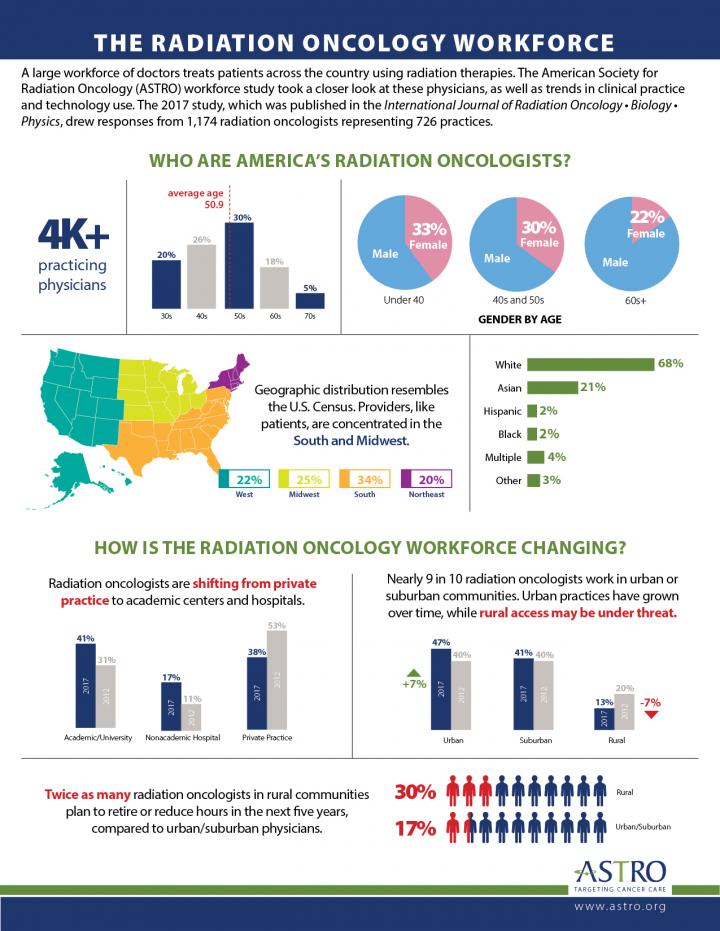
Credit: American Society for Radiation Oncology (ASTRO)
ARLINGTON, Va., April 4, 2019 — The newest study of America’s radiation oncology workforce finds that gender and race gaps have narrowed slightly, although persistent and growing geographic disparities point to a need for more equity in access to radiation therapy care. The survey, which drew responses from more than 1,100 physicians across the country, finds that fewer radiation oncologists are practicing in rural communities and that these doctors are more likely to retire in the coming years.
Results of the American Society for Radiation Oncology (ASTRO) 2017 Radiation Oncologist Workforce Study are published in the March issue of the International Journal of Radiation Oncology * Biology * Physics (Red Journal), and an infographic summarizing the results is also available.
Key takeaways from the study include:
(1) Shift from rural to suburban and urban locations: Nearly nine in 10 radiation oncologists work in urban or suburban communities (47% and 41%, respectively). Since the previous workforce survey in 2012, the proportion of rural radiation oncologists declined from 16 to 13 percent, indicating that rural access to radiation therapy services may be under threat.
The trend may be exacerbated by disproportionately more physicians leaving the rural workforce and fewer new physicians taking positions in these communities. Nearly 30 percent of radiation oncologists in rural communities plan to retire or reduce hours in the next five years, compared to 18 percent of urban/suburban physicians. Moreover, surveys of recent radiation oncology graduates point to growing demand for jobs in major cities coupled with waning demand for those in smaller cities.
In response to this trend, ASTRO launched an initiative in early 2019 focusing on rural access to radiation oncology care. A group of physicians led by former ASTRO Chair David Beyer, MD, FASTRO, will explore factors behind the shift, as well as strategies to protect and bolster access.
“One in five Americans – about 60 million people – live in rural communities, and most of these people want their medical care close to home. For many patients, access is the difference between being treated or not being treated, and so we are trying to understand – what are the obstacles that keep a lack of access from being their reality?” said Dr. Beyer. “Unfortunately, this trend is not unique to radiation oncology and is a problem across health care. In the rural Arizona community where I practice, for example, there is a shortage of primary care physicians. There is a shortage of surgeons. There are many shortages.”
(2) Movement toward gender equity: The number of female radiation oncologists edged up 3 percent from the previous survey, from 26 to 29 percent. Women also are more common in newer cohorts within the workforce; female physicians were 33 percent of radiation oncologists under age 40, 30 percent of those in their 40s and 50s, and 22 percent of those age 60 and up
(3) Shift from private practice to academic hubs: Radiation oncologists also are shifting from working primarily in private practice to treating patients at academic centers and hospitals. The 2017 survey marks the first time that fewer than half of these doctors work in private practice (38%), with 41 percent practicing at academic/university centers and 17 percent at non-academic hospitals.
(4) Widespread adoption of new technology: 95 percent of practices offer shortened, or hypofractionated, radiation therapy, providing their patients a more convenient treatment option without increasing the risk of side effects or the cancer returning. The most common tumors for hypofractionation include breast tumors (94% of practices), bone metastases (92%) and brain metastases (74%). Clinics also increased adoption of advanced technologies and techniques for providing radiation therapy treatments, such as stereotactic radiation and real-time image guidance.
“In some ways, the radiation oncology workforce is changing to look more like the patients we treat. The modest but noticeable increases in the number of women and racial/ethnic minorities, for example, indicate that our field is moving toward more equity,” said Claire Y. Fung, MD, Chair of the ASTRO Workforce Subcommittee, which conducted the study, and a radiation oncologist at Beth Israel Deaconess Medical Center in Boston. “The shifts in employment patterns and the movement from rural practices to urban hubs, however, point to possible areas of disparity in access to care. Studies such as this one help ASTRO and other health care groups recognize these threats and address them proactively.”
ASTRO conducts workforce studies to identify trends in provider demographics, employment and technology use, and to assess the profession’s ability to meet patient needs. The 2017 survey was conducted online, and findings reflect responses from 1,174 radiation oncologists representing 726 practices (31% response rate).
Article Details
- The American Society for Radiation Oncology 2017 Radiation Oncologist Workforce Study
- Claire Y. Fung, MD, Erli Chen, MS, Neha Vapiwala, MD, Surjeet Pohar, MD, Daniel Trifiletti, MD, Minh-Tam Truong, MD, George Uschold, EdD, Jessica Schuster, MD, Akshar Patel, MD, Ashesh Jani, MD, Pranshu Mohindra, MD, Tim Sanders, BS, Liz Gardner, PhD, Anna Arnone, Trevor Royce, MD, MPH
- International Journal of Radiation Oncology
- Biology
- Physics, Volume 103, Issue 3, Pages 547-556
- https:/
/ (18)33907-5/, https:/www. redjournal. org/ article/ S0360-3016 / doi. org/ 10. 1016/ j. ijrobp. 2018. 10. 020
ABOUT ASTRO
The American Society for Radiation Oncology (ASTRO) is the world’s largest radiation oncology society, with more than 10,000 members who are physicians, nurses, biologists, physicists, radiation therapists, dosimetrists and other health care professionals who specialize in treating patients with radiation therapies. The Society is dedicated to improving patient care through professional education and training, support for clinical practice and health policy standards, advancement of science and research, and advocacy. ASTRO publishes three peer-reviewed journals, the International Journal of Radiation Oncology
(redjournal.org), Practical Radiation Oncology (practicalradonc.org) and Advances in Radiation Oncology (advancesradonc.org); developed and maintains an extensive patient website, RT Answers (rtanswers.org); and created the Radiation Oncology Institute (roinstitute.org), a nonprofit foundation to support research and education efforts around the world that enhance and confirm the critical role of radiation therapy in improving cancer treatment. To learn more about ASTRO, visit http://www.
###
Media Contact
Liz Gardner
[email protected]
Related Journal Article
http://dx.




